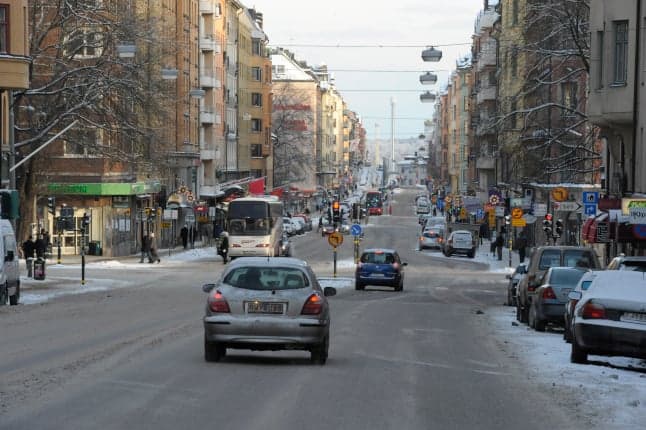This Stockholm street just became the first in Sweden to ban old diesel cars

From today onwards, some cars will no longer be allowed to use one of southern Stockholm's main thoroughfares.
Hornsgatan runs from north to west on Stockholm's Södermalm island. It is a busy street lined with shops, bars and restaurants, and one of the quickest ways for drivers to get from Slussen to Liljeholmen.
It is also one of the Swedish capital's most polluted streets, and other measures such as banning studded winter tyres have previously been adopted in order to improve its air quality.
And on January 15th, a ban on old diesel cars comes into force on the street.
It follows a decision by the Swedish government in 2018 to make it possible for local authorities to create so-called environmental zones, and was a key question in the local election in Stockholm the same year.
The scheme was eventually pushed through by the Green Party, who have been ruling in coalition with centre-right parties in Stockholm City Council since the election, with opponents claiming a diesel ban was unnecessary due to the continuing improvement of air quality in the Swedish capital.
The ban means that only newer diesel engines meeting the emission standards of Euro 5 and Euro 6 will be permitted in the zone, and by 2022 only Euro 6 will be allowed. In practice, this bans most cars older than 11 years, but note that the older cars will still be allowed to cross Hornsgatan.
There are already class-one environmental zones for heavy vehicles in place in several Swedish cities (Stockholm, Gothenburg, Malmö, Mölndal, Uppsala, Helsingborg, Lund and Umeå). But Hornsgatan is the first street in Sweden to introduce a class-two environmental zone for passenger cars.
According to Swedish public broadcaster SVT, around 4,000 of the 24,000 cars that use Hornsgatan every day will now be forced to take a detour. Emergency vehicles are however not affected by the ban.
Alternative routes from Slussen to Liljeholmen or to the E4/E20 motorway through the city are the Söder Mälarstrand street and then Västerbron, alternatively Götgatan or Söderledstunneln south, joining the 75 westbound through Årsta before reaching Liljeholmen or the motorway. In any case, unless you have no other option, public transport is usually more convenient than driving in central Stockholm.
Comments
See Also
Hornsgatan runs from north to west on Stockholm's Södermalm island. It is a busy street lined with shops, bars and restaurants, and one of the quickest ways for drivers to get from Slussen to Liljeholmen.
It is also one of the Swedish capital's most polluted streets, and other measures such as banning studded winter tyres have previously been adopted in order to improve its air quality.
And on January 15th, a ban on old diesel cars comes into force on the street.
It follows a decision by the Swedish government in 2018 to make it possible for local authorities to create so-called environmental zones, and was a key question in the local election in Stockholm the same year.
The scheme was eventually pushed through by the Green Party, who have been ruling in coalition with centre-right parties in Stockholm City Council since the election, with opponents claiming a diesel ban was unnecessary due to the continuing improvement of air quality in the Swedish capital.
The ban means that only newer diesel engines meeting the emission standards of Euro 5 and Euro 6 will be permitted in the zone, and by 2022 only Euro 6 will be allowed. In practice, this bans most cars older than 11 years, but note that the older cars will still be allowed to cross Hornsgatan.
There are already class-one environmental zones for heavy vehicles in place in several Swedish cities (Stockholm, Gothenburg, Malmö, Mölndal, Uppsala, Helsingborg, Lund and Umeå). But Hornsgatan is the first street in Sweden to introduce a class-two environmental zone for passenger cars.
According to Swedish public broadcaster SVT, around 4,000 of the 24,000 cars that use Hornsgatan every day will now be forced to take a detour. Emergency vehicles are however not affected by the ban.
Alternative routes from Slussen to Liljeholmen or to the E4/E20 motorway through the city are the Söder Mälarstrand street and then Västerbron, alternatively Götgatan or Söderledstunneln south, joining the 75 westbound through Årsta before reaching Liljeholmen or the motorway. In any case, unless you have no other option, public transport is usually more convenient than driving in central Stockholm.
Join the conversation in our comments section below. Share your own views and experience and if you have a question or suggestion for our journalists then email us at [email protected].
Please keep comments civil, constructive and on topic – and make sure to read our terms of use before getting involved.
Please log in here to leave a comment.